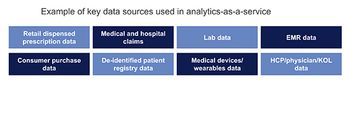
How artificial intelligence, wearable devices, and translational informatics are changing healthcare.

How artificial intelligence, wearable devices, and translational informatics are changing healthcare.

Keshia Vaughn looks at how machine learning can transform commercial planning and outlines what teams will need to deploy it effectively.

Although it is unlikely that mock demonstrators will be seen at any drug information or regulatory conferences, pharmacovigilance software is indeed having its “Salesforce” moment.

The next generation of supply chain shows an increasing need for blockchain technology.

As pharm execs look to real-world data to aid in translational research and close the gap from traditional clinical trials to real-world efficacy, there are three foundational pillars to build from. Bill Fox reports.

AI has become ubiquitous in all industries, including life sciences. But is also attracting some concerns – particularly around job losses, ethics, and more broadly, how successful it really is, writes Steve Arlington.

Brands should look to their agencies to be a true data-driven business partner, not just a creative partner, writes Kevin Troyanos.

There’s a growing realization that advances in connected devices, sensors and predictive analytics represent a game-changer when it comes to patient support programs (PSPs), writes Jim O'Donaghue.

For pharma leaders, AI can bring about a new reality of seeing a multitude of possible paths, forecasting the interplay of multi-dimensional trends, and charting patient journeys that are based on reality, writes Aswin Chandrakantan.

With specialty companies getting smarter in applying their big data insights to product marketing, the true commercial potential of machine learning and predictive modeling may soon be within reach.

An overview of Orphan Reinsurer and Benefit Managers groups, including potential challenges with the model and various model suggestions.

How pharma companies are leveraging natural language processing (NLP) for rapid and effective handling of unstructured text.

Analytics as a service can provide critical accelerators for the commercial transformation program at a life sciences organization, writes Himanshu Jain.

Benefit verification (BV) provides a detailed understanding of out of pocket costs for the prescribed treatment. Amy Jones details how AI is aiding the BV process.

While digital transformation in life sciences starts with digitization for compliance, it should be seen as a key lever of competitive advantage and success, writes Jaleel Shujath.

Artificial intelligence adoption by pharma companies in the UK demands a new, agile governance layer, write Tim Wright and Antony Bott.


If advanced technologies hold the key to at least some of the productivity issues R&D organizations need to overcome, Nicholas Lakin asks what are the best strategies and operating models for exploiting these aids to their fullest potential.


Traditional scientific search is broken. AI-supported smart searching is the answer, writes Jane Reed.

Ron Wince explains how Pragmatic AI allows organizations to start with the basics, create immediate business value and ROI and then increase adoption as their comfort, capabilities and confidence increases.

At this month's AMPLEXOR Life Sciences’ “Be The Expert” conference, Pharm Exec caught up with Steve Gens, who talked about the evolution of Regulatory Information Management (RIM) and offered some predictions for 2022.

Realistic, multisensory training devices can contribute to a drug’s reception in the eyes of both patients and healthcare practitioners, writes Paul Sullivan.

Ilyssa Levins talks to Pharm Exec about some of the regulatory, compliance and legal challenges posed by the digital health revolution.

From AI to Alexa, experts in specialty pharma ponder the possibilities for high tech and the patient journey.